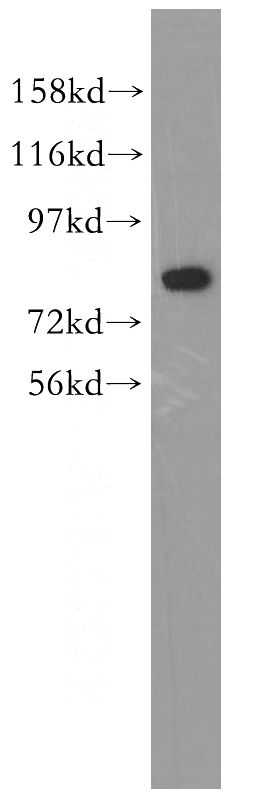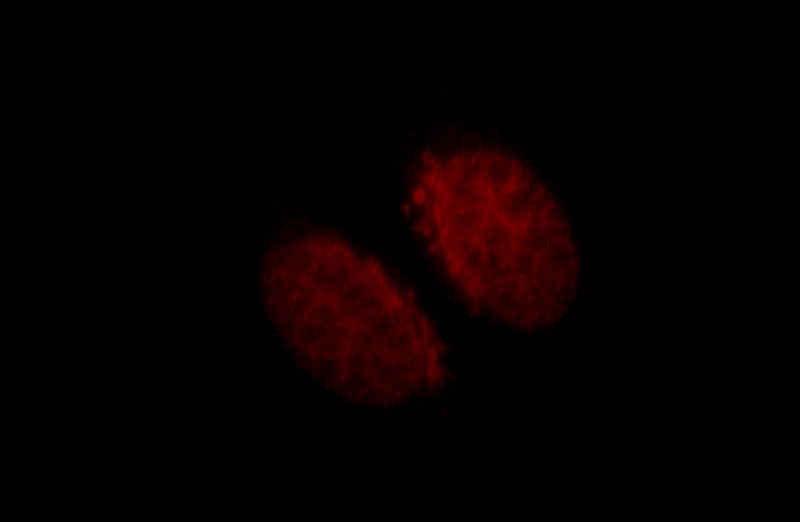-
Product Name
CUX1 antibody
- Documents
-
Description
CUX1 Rabbit Polyclonal antibody. Positive IF detected in HepG2 cells. Positive IP detected in mouse brain tissue. Positive WB detected in human brain tissue, human liver tissue, Jurkat cells, mouse brain tissue, mouse liver tissue, rat brain tissue. Observed molecular weight by Western-blot: 80kd
-
Tested applications
ELISA, WB, IF, IP
-
Species reactivity
Human,Mouse,Rat; other species not tested.
-
Alternative names
CASP antibody; CCAAT displacement protein antibody; CDP antibody; CDP/Cut antibody; CDP1 antibody; Clox antibody; COY1 antibody; cut like homeobox 1 antibody; CUTL1 antibody; CUX antibody; Cux/CDP antibody; CUX1 antibody; GOLIM6 antibody; Homeobox protein cut like 1 antibody; Homeobox protein cux 1 antibody; Nbla10317 antibody; p100 antibody; p110 antibody; p200 antibody; p75 antibody
-
Isotype
Rabbit IgG
-
Preparation
This antibody was obtained by immunization of CUX1 recombinant protein (Accession Number: NM_181500). Purification method: Antigen affinity purified.
-
Clonality
Polyclonal
-
Formulation
PBS with 0.1% sodium azide and 50% glycerol pH 7.3.
-
Storage instructions
Store at -20℃. DO NOT ALIQUOT
-
Applications
Recommended Dilution:
WB: 1:1000-1:10000
IP: 1:500-1:5000
IF: 1:10-1:100
-
Validations

human brain tissue were subjected to SDS PAGE followed by western blot with Catalog No:109628(CUX1 antibody) at dilution of 1:2000

Immunofluorescent analysis of HepG2 cells, using CUX1 antibody Catalog No:109628 at 1:25 dilution and Rhodamine-labeled goat anti-rabbit IgG (red).

IP Result of anti-CUX1 (IP:Catalog No:109628, 4ug; Detection:Catalog No:109628 1:1000) with mouse brain tissue lysate 4000ug.
-
Background
CUX1 is a transcription factors that regulates a large number of genes and microRNAs involved in multiple cellular processes, such as DNA replication, progression into S phase and later, the spindle assembly checkpoint that controls progression through mitosis. CUX1 acts by preventing binding of positively-acting CCAAT factors to promoters to mediated its gene reperssion. Also it's a component of nf-munr repressor, and binds to the matrix attachment regions (MARs) (5' and 3') of the immunoglobulin heavy chain enhancer. It can represses T-cell receptor (TCR) beta enhancer function by binding to MARbeta, an ATC-rich DNA sequence located upstream of the TCR beta enhancer
-
References
- Wong CC, Martincorena I, Rust AG. Inactivating CUX1 mutations promote tumorigenesis. Nature genetics. 46(1):33-8. 2014.
- Gokhale A, Larimore J, Werner E. Quantitative proteomic and genetic analyses of the schizophrenia susceptibility factor dysbindin identify novel roles of the biogenesis of lysosome-related organelles complex 1. The Journal of neuroscience : the official journal of the Society for Neuroscience. 32(11):3697-711. 2012.
Related Products / Services
Please note: All products are "FOR RESEARCH USE ONLY AND ARE NOT INTENDED FOR DIAGNOSTIC OR THERAPEUTIC USE"
